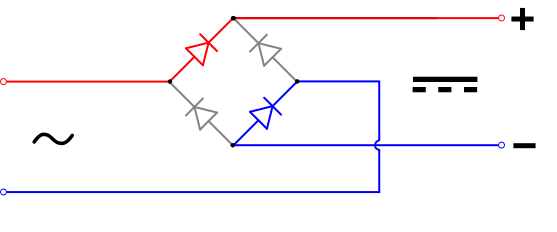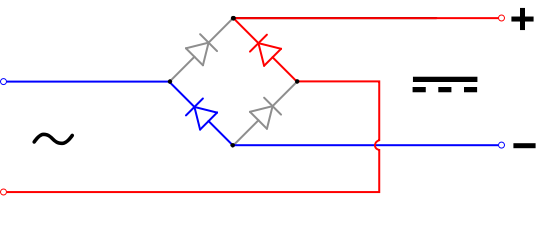Chapter 3
Diodes
- Forward bias occurs when the P-type semiconductor material is connected to the positive terminal of a battery and the N-type semiconductor material is connected to the negative terminal, as shown below. This usually makes the p–n junction conduct. <ref> Wikipedia P-N junction</ref>
- Because diodes are a nonlinear device, traditional circuit analysis will not work on them. One method of analyze the diodes is to do it graphically. This technique is called Load-line analysis.
- The load-line equation is obtained by applying KVL or KCL. The equation plots as a straight line that can be drawn by locating two points.
- In circuits with multiple diodes, it is not immediately apparent which diodes are on or off. The ideal-diode model assumes that the diode is a perfect conductor with zero voltage drop in the forward direction and an open circuit in the reverse direction.
- Assume a set of states for the diodes
- Solve the circuit to find for diodes assumed to be on and for diodes assumed to be off
- Check to see if is positive for all diodes assumed to be on and if is negative for all diodes assumed to be off.
- Explain peak inverse voltage, PIV.
Full Wave Recififier: Center-tapped Transformer

Full Wave Recitifier: Diode Bridge


- The diode bridge has a larger voltage drop due to two diodes in comparison to the center-tapped transformer.
Clipper Circuit
- A battery + diode can be used to clip the circuit. A Zener diode will often take the place of the battery in a clipper circuit.
- Placing a resistor in series with the diodes can allow for more gradual transfer characteristics.
Clamp Circuit
- Diodes are then used to define the upper and lower limit by conducting if the voltage goes outside their specified range.
- The direction of the diode will determine whether the positive or negative peaks are clamped.
- The charged capacitor value will determine the value the peaks are clamped at.
Linear Small-Signal Equivalent Circuits
- Dc supply voltages are used to bias a nonlinear device at an operating point and a small ac signal is injected into the circuit. If we consider a small enough region of operation, we can find a linear small-signal equivalent circuit.<ref>Electronics p156</ref>
- The DC supply voltage results in the circuit operating at the quiescent point. We can use this point to find the dynamic resistance of the diode.
- The analysis of nonlinear electronic circuits is often accomplished in two steps: First, the dc operating point is determined, and a linear small-signal equivalent circuit is found for the nonlinear devices; second, the equivalent circuit is analyzed. <ref>Electronics p188</ref>
- Shockley Diode equation:
- is the saturation current:
- is the thermal voltage:
- Dynamic small-signal resistance of the diode at the Q-point:
To Do
- Start up Chapter 3 problems
- Extend the bag of tricks post. Have subsections for op amps and diodes now. Then BJTs later.
References
<references/>